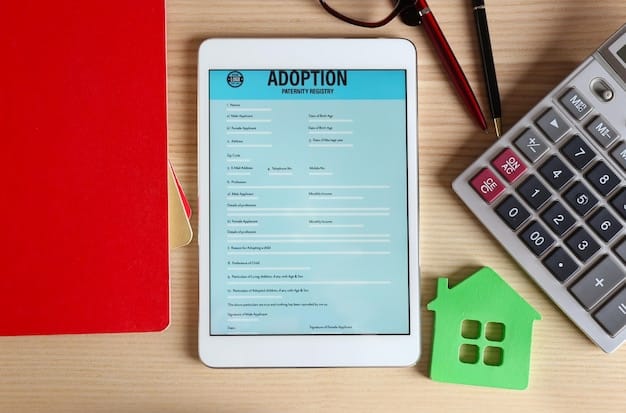US Childcare Subsidies Guide: Eligibility & Application (2025)

The Ultimate Guide to US Childcare Subsidies: Eligibility and Application Process in 2025 provides crucial information for parents and guardians seeking financial assistance for childcare, outlining eligibility requirements, application procedures, and available programs to help ease the burden of childcare expenses.
Navigating the complexities of childcare can be overwhelming, especially when considering the financial aspect. This comprehensive resource, The Ultimate Guide to US Childcare Subsidies: Eligibility and Application Process in 2025, will equip you with the knowledge to understand and access available support programs to ensure quality care for your children.
Understanding US Childcare Subsidies: An Overview
Childcare subsidies are government-funded programs designed to help eligible families afford childcare. These subsidies play a crucial role in supporting working parents, enabling them to maintain employment while ensuring their children receive safe and nurturing care. Understanding the landscape of these subsidies is the first step in accessing the support you need.
The Significance of Childcare Subsidies
Childcare costs can be a significant financial burden for many families, often exceeding housing or food expenses. Subsidies alleviate this burden, allowing parents to participate in the workforce and contribute to the economy. They also promote early childhood development by providing access to quality care environments.
Federal vs. State Childcare Programs
Childcare subsidies in the US are administered through a combination of federal and state programs. The federal government provides funding and sets broad guidelines, while individual states have the flexibility to design and implement programs that best meet the needs of their residents. This results in variations in eligibility criteria, benefit levels, and application processes across different states.
- Federal Funding: Primarily through the Child Care and Development Fund (CCDF).
- State Administration: Each state manages its own childcare subsidy program.
- Variations: Eligibility and benefits vary significantly by state.
Therefore, it’s essential to research and understand the specific programs available in your state to determine your eligibility and navigate the application process effectively. Resources like your state’s Department of Early Education and Care can provide detailed information.
In conclusion, understanding the basics of US childcare subsidies, including their purpose and the interplay between federal and state programs, is essential for navigating the support available to families. By gaining clarity on this landscape, parents can take the first step towards accessing the resources that can make quality childcare more affordable and accessible.
Determining Your Eligibility for Childcare Assistance
Eligibility for childcare subsidies in the US is not universal; it depends on a variety of factors. Understanding the key criteria is vital to determining whether you qualify for assistance. Common eligibility factors include income, family size, work or education status, and the age of the child.

Income Requirements and Thresholds
Income is a primary determinant of eligibility for most childcare subsidy programs. States set income thresholds, typically expressed as a percentage of the federal poverty level or the state median income. Families with incomes below these thresholds may be eligible for assistance. However, the specific income limits vary significantly from state to state.
Work or Education Requirements
Many childcare subsidy programs require parents to be employed, attending school, or participating in a job training program. This requirement underscores the goal of supporting working families and promoting self-sufficiency. The number of hours required for work or school may also vary by state.
Child’s Age and Special Needs
The age of the child needing care is another factor. Most programs provide assistance for children from infancy through preschool age. Some programs may also offer assistance for school-age children who require before-and-after school care. Additionally, children with special needs may qualify for extended or specialized care, regardless of parental employment status in some cases.
- Income Limits: Vary by state, based on poverty level or median income.
- Work/Education: Often require employment, school attendance, or job training.
- Age of Child: Typically covers infants to preschool-age children.
To accurately assess your eligibility, consult your state’s childcare subsidy program guidelines. They will provide detailed information on income thresholds, work or education requirements, and age limits. Knowing these specifics will enable you to confidently proceed with the application process.
In essence, thoroughly understanding the eligibility criteria for childcare assistance, encompassing income, work or education status, and the child’s age, is critical for parents seeking to access this support. By carefully reviewing these requirements, families can determine their eligibility and start the application process with confidence.
Step-by-Step Guide to Applying for Childcare Subsidies
The application process for childcare subsidies can seem daunting, but it becomes manageable when broken down into clear steps. Here is a comprehensive guide to help you navigate the process effectively, ensuring you gather all the necessary information and documentation.
Researching Your State’s Specific Program
Each state has its own unique childcare subsidy program, so the first step is to research the specifics of the program in your state. Start by visiting your state’s Department of Early Education and Care website, or a similar agency. Look for information on eligibility requirements, application forms, and contact information for local offices.
Gathering Necessary Documentation
Before you begin filling out the application, gather all the required documentation. This typically includes proof of income (pay stubs, tax returns), proof of residency (utility bill, lease agreement), proof of employment or enrollment in school/training, and the child’s birth certificate or other identification. Having these documents readily available will streamline the application process.
Completing and Submitting the Application
Once you have gathered all the necessary documentation, carefully complete the application form. Be sure to answer all questions accurately and honestly. Once completed, submit the application according to the instructions provided by your state’s program. This may involve mailing the application to a local office, submitting it online, or visiting an office in person.

- Research: Investigate your state’s Department of Early Education and Care.
- Documentation: Collect income proof, residency proof, and child’s birth certificate.
- Submission: Follow the state’s instructions for submitting the application.
By following these steps – researching your state’s program, gathering necessary documentation, and carefully completing and submitting the application – you can navigate the process of applying for childcare subsidies with confidence. This structured approach will help ensure that your application is complete and accurate, maximizing your chances of approval.
To summarize, a well-organized approach to applying for childcare subsidies, which includes thorough research, careful documentation, and accurate application submission, makes the process more manageable and increases the likelihood of receiving financial assistance.
Understanding Benefit Levels and Payment Structures
Once you are approved for childcare subsidies, it’s essential to understand how the benefit is calculated and how the payments are structured. This will help you budget effectively and ensure that you are maximizing the assistance you receive. Benefit levels and payment structures can vary significantly from state to state and even within different programs within the same state.
How Benefits are Calculated
The amount of childcare subsidy you receive is typically based on several factors, including your income, family size, the age of your child, and the type of childcare you choose. Some states use a sliding scale, where the benefit amount decreases as your income increases. Other states may have fixed benefit amounts based on specific income brackets. Additionally, the type of childcare you select (e.g., licensed center, family daycare, in-home care) may affect the amount of assistance you receive.
Payment Structures and Options
Childcare subsidy payments can be structured in various ways. Some states provide direct payments to childcare providers, while others provide vouchers or certificates that parents can use to pay for care. In some cases, parents may be required to pay a co-payment, which is a portion of the childcare cost that they are responsible for covering. Understanding the payment structure in your state is crucial for managing your childcare expenses effectively.
Factors Affecting Benefit Amounts
Several factors can affect the amount of childcare subsidy you receive. Changes in your income, family size, or work/education status can all impact your benefit level. Additionally, some states may have waiting lists or limited funding, which can affect the availability and amount of assistance. It’s important to keep your state’s program informed of any changes in your circumstances that could affect your eligibility or benefit amount.
- Calculation: Based on income, family size, child’s age, and childcare type.
- Payment: Direct payments, vouchers, or certificates to providers.
- Factors: Income changes, family size changes, and program funding.
By understanding how benefit levels are calculated, how payments are structured, and the factors that can affect your benefit amount, you can better manage your childcare expenses and ensure that you are receiving the maximum assistance for which you are eligible. Staying informed and communicating with your state’s program is key to maximizing the benefits you receive.
In summary, obtaining a clear understanding of benefit calculations, payment structures, and influencing factors is essential for effectively managing childcare expenses and maximizing the financial aid received through subsidy programs.
Maintaining Eligibility and Renewing Your Subsidy
Receiving childcare subsidies is a great benefit, but it’s crucial to understand the requirements for maintaining your eligibility and renewing your subsidy when necessary. Failure to meet these requirements can result in a loss of benefits, so staying informed and proactive is essential.
Reporting Changes in Circumstances
Most childcare subsidy programs require you to report any changes in your circumstances that could affect your eligibility. This includes changes in income, employment status, family size, or address. Reporting these changes promptly is crucial because they can impact your benefit level or even your continued eligibility for the program. Failure to report changes could result in overpayment of benefits, which you may be required to repay.
Completing Periodic Reviews or Recertification
Many childcare subsidy programs require periodic reviews or recertification to ensure that you still meet the eligibility requirements. This typically involves submitting updated documentation, such as pay stubs, proof of residency, and verification of employment or school enrollment. Be sure to complete these reviews or recertification processes by the designated deadlines to avoid a lapse in your benefits.
Avoiding Common Pitfalls
There are several common pitfalls that can lead to a loss of childcare subsidies. These include failing to report changes in circumstances, not completing periodic reviews, and providing inaccurate information on your application. To avoid these issues, stay organized, keep your contact information up-to-date with the program, and carefully review all documentation before submitting it.
- Report Changes: Income, employment, family size, address.
- Recertification: Complete reviews and submit updated documentation.
- Avoid Pitfalls: Stay organized and provide accurate information.
By diligently reporting changes in circumstances, completing periodic reviews, and avoiding common pitfalls, you can successfully maintain your eligibility and renew your childcare subsidy when necessary. This proactive approach will ensure that you continue to receive the financial assistance you need to provide quality care for your children.
In short, proactive management of your childcare subsidy by reporting changes, completing reviews, and avoiding common mistakes is key to maintaining eligibility and continuing to receive valuable support.
Exploring Additional Resources and Support
While childcare subsidies are a significant source of financial assistance, there are often additional resources and support systems available to families. Exploring these options can provide even greater assistance in managing childcare expenses and ensuring your child receives quality care.
Head Start and Early Head Start Programs
Head Start and Early Head Start are federally funded programs that provide comprehensive early childhood education, health, nutrition, and parent involvement services to low-income children and families. These programs are available for children from birth to age five and offer a range of services designed to promote school readiness and overall well-being. Eligibility is based on income, and priority is given to families with the lowest incomes.
State-Funded Pre-K Programs
Many states offer publicly funded pre-kindergarten (pre-K) programs for children ages three and four. These programs provide high-quality early learning experiences that prepare children for kindergarten and beyond. Eligibility requirements vary by state, but they are typically based on age and residency. Some programs may also have income requirements or prioritize children with special needs.
Tax Credits and Dependent Care Assistance Programs
In addition to direct subsidies and early childhood programs, there are also tax credits and dependent care assistance programs that can help offset childcare expenses. The Child and Dependent Care Tax Credit allows eligible families to claim a credit for a portion of their childcare expenses on their federal income tax return. Dependent Care Assistance Programs (DCAPs) allow employees to set aside pre-tax dollars to pay for eligible childcare expenses through their employer.
- Head Start: Comprehensive services for low-income families (birth to age 5).
- State Pre-K: Publicly funded early learning programs (ages 3 and 4).
- Tax Credits: Federal credits for childcare expenses.
By exploring these additional resources and support systems, you can maximize your financial assistance for childcare and ensure that your child receives the highest quality care possible. Combining childcare subsidies with other available programs and tax benefits can significantly ease the financial burden of childcare and create a brighter future for your family.
In conclusion, leveraging a combination of childcare subsidies, early childhood programs, and tax benefits can significantly alleviate the financial strain of childcare and ensure children receive exceptional care.
| Key Point | Brief Description |
|---|---|
| 💰 Eligibility | Income, work status, and child’s age affect qualification. |
| 📝 Application Process | Research state-specific programs and gather required documents. |
| ✅ Maintaining Benefits | Report any changes in circumstances promptly. |
| 💡 Additional Resources | Explore Head Start, pre-K programs, and tax credits. |
Frequently Asked Questions
▼
Childcare subsidies are government-funded programs that help eligible families afford childcare, supporting working parents and promoting early childhood development by providing access to quality care.
▼
Eligibility typically depends on factors like income, family size, work or education status, and the child’s age. Requirements vary by state, so checking local guidelines is crucial for accurate information.
▼
Start by researching your state’s program and gathering necessary documents like proof of income, residency, and employment. Complete and submit the application accurately, following state-specific instructions.
▼
Benefit levels are usually calculated based on income, family size, and the type of childcare chosen. States may use a sliding scale or fixed amounts, affecting the subsidy amount received.
▼
Maintain eligibility by reporting changes in circumstances promptly, completing periodic reviews, and avoiding common pitfalls like providing inaccurate information or missing deadlines for recertification.
Conclusion
Navigating the world of US childcare subsidies can be complex, but with this guide, you’re now equipped with the knowledge to understand eligibility requirements, navigate the application process, and explore additional resources. By understanding these programs, you can ensure your children receive the care they need while easing the financial burden on your family.





